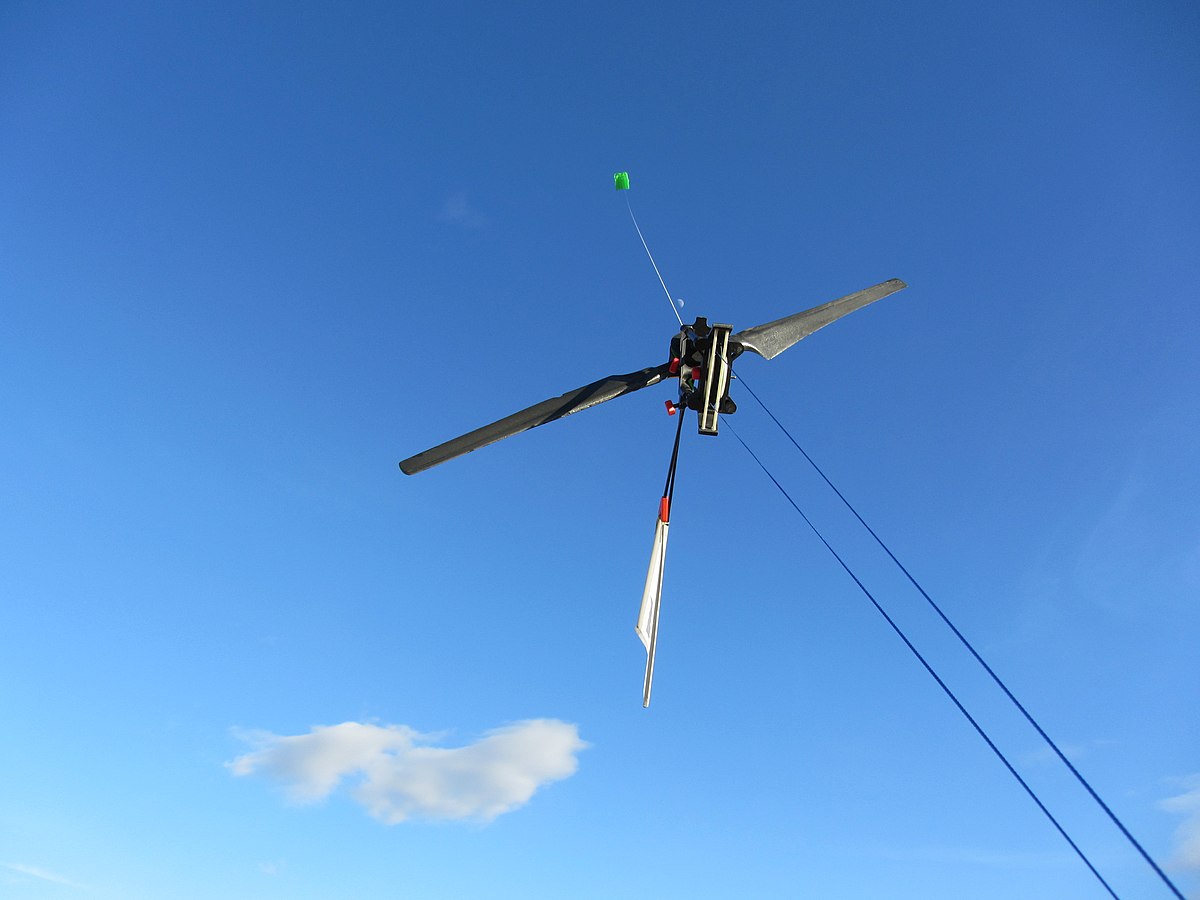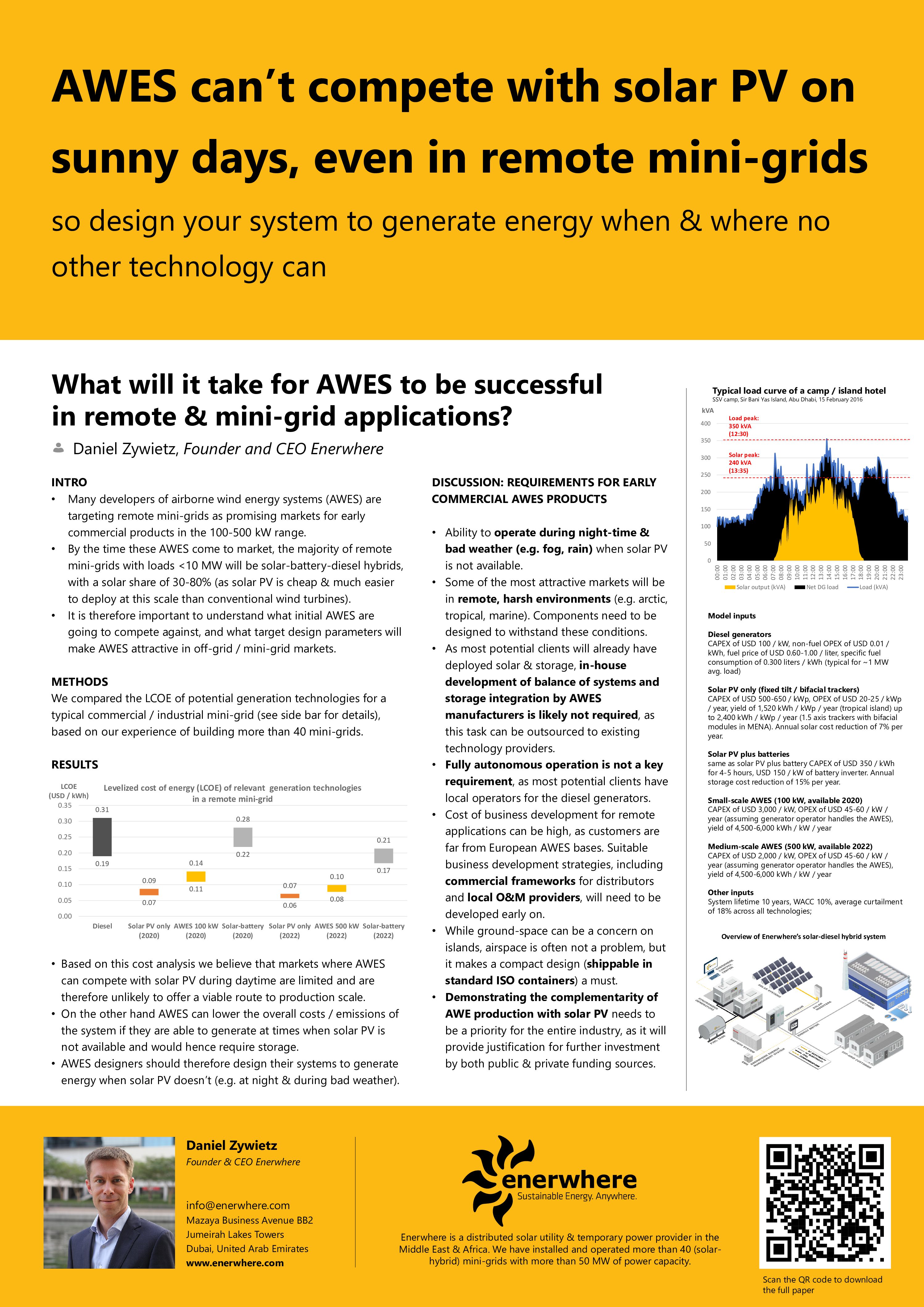Model inputs
We compared the LCOE of potential generation technologies for a typical commercial / industrial mini-grid (see side bar for details), based on our experience of building more than 40 mini-grids.
Diesel generators
CAPEX of USD 100 / kW, non-fuel OPEX of USD 0.01 / kWh, fuel price of USD 0.60-1.00 / liter, specific fuel consumption of 0.300 liters / kWh (typical for ~1 MW avg. load)
Solar PV only (fixed tilt / bifacial trackers)
CAPEX of USD 500-650 / kWp, OPEX of USD 20-25 / kWp / year, yield of 1,520 kWh / kWp / year (tropical island) up to 2,400 kWh / kWp / year (1.5 axis trackers with bifacial modules in MENA). Annual solar cost reduction of 7% per year.
Solar PV plus batteries
same as solar PV plus battery CAPEX of USD 350 / kWh for 4-5 hours, USD 150 / kW of battery inverter. Annual storage cost reduction of 15% per year.
Small-scale AWES (100 kW, available 2020)
CAPEX of USD 3,000 / kW, OPEX of USD 45-60 / kW / year (assuming generator operator handles the AWES), yield of 4,500-6,000 kWh / kW / year
Medium-scale AWES (500 kW, available 2022)
CAPEX of USD 2,000 / kW, OPEX of USD 45-60 / kW / year (assuming generator operator handles the AWES), yield of 4,500-6,000 kWh / kW / year
Other inputs
System lifetime 10 years, WACC 10%, average curtailment of 18% across all technologies;

By Olivierabristol – Own work, CC BY-SA 4.0, Link
What will it take for Airborne Wind Energy (AWE) to be successful in Remote & Mini-grid Applications?
Daniel Zywietz, Dubai, 13 October 2019
AWES show promise to greatly increase the potential of wind harvesting on a global scale, however, initially costs will be significantly higher than those of other renewable energy source like solar PV & conventional wind plants. For this reason, many AWE system integrators target off-grid / mini-grid markets for their initial commercial products in the 100-500 kW range, as cost-constraints are believed to be less of a hurdle in these markets.
While this appears to be a viable strategy to increase the number deployed units and drive down cost via learning effects, a number of critical real-world parameters need to be considered for the design of these initial products.
What are initial AWES going to compete against, and hence what are the target design parameters that would make AWES cost-competitive in the off-grid / mini-grid market?
Modern mini-grids generally use a solar-battery system with diesel backup, achieving a 30-70% solar share. The key reason to add AWES will be to increase the share of renewables at a cost below that of additional solar PV & storage. AWES will not be able to compete with solar PV during daylight hours in most locations, as PV costs are already very low (investment costs of <$150 / kWh / day). Instead, AWES are needed at night and during bad weather, when solar PV would require storage, driving up investment costs to around $500 / kWh / day (in 2019 but falling by ~10% annually).

Levelized cost of energy (LCOE) of relevant generation technologies in a remote mini-grid
This leads to some requirements for early commercial AWES products:
- Ability to operate during night-time and bad weather need to be demonstrated early on.
- Initial mini-grid deployments will often be located in remote, harsh (e.g. arctic, tropical, marine) environments and components need to be designed to withstand these conditions.
- Given that most potential clients will already have deployed solar and storage, in-house development of balance of systems and storage integration by AWES manufacturers is probably not required, as this task can be outsourced to existing technology providers.
- Fully autonomous operation is not a key requirement, as most potential clients have local operators for the diesel generators anyway.
- Cost of business development for these applications is high, as customers are in remote locations. Suitable business development strategies, including commercial frameworks for distributors and local O&M providers, will need to be developed early on.
- While ground-space can be a concern on islands, airspace is often not a problem (due to the very remoteness). The same reason makes a compact design (shippable in standard ISO containers) a must.
- Demonstrating the complementarity of AWE production with solar PV needs to a priority for the industry, as this will provide a justification for further investment by both public & private funding sources, even when other RE technologies have already reached much lower price points.


